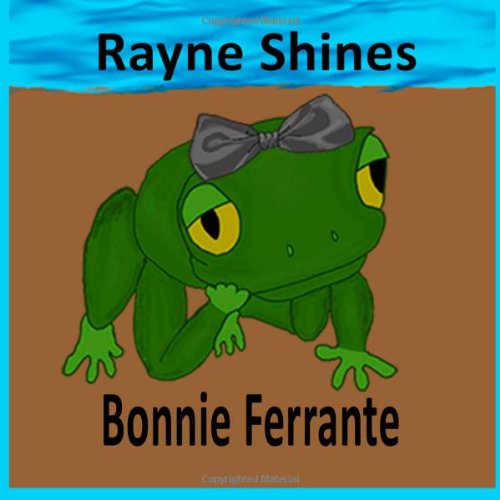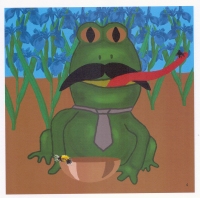| ________________
CM . . .
. Volume XX Number 34. . . .May 2, 2014
excerpt:
Both of Rayne’s parents are “glass-half-empty” individuals who apparently see only the negative side of everything. Being brought up in this environment, Rayne has adopted the pessimistic stance she sees being modeled by her parents. Consequently, when the Gray family decides to dine out (their response to having criticized the food they have already prepared for themselves), Rayne decides she can’t eat what she has ordered after hearing her parents complain about the awful menu and dreadful service. Change begins to come for Rayne when she observes volunteers constructing a new house next door (Habitat for Amphibians?). While her parents object to the house’s shape and colour, Rayne wonders, “Why are they [the volunteers] so happy?” A new family occupies the house, but the Grays do not go over to introduce themselves. Instead, Rayne’s father criticizes the new family’s truck, and her mother describes the neighbours’ furniture as “dreadful”. Interestingly, Rayne does not comment, but she is aware that:
The book’s message is both obvious and subtle and speaks as well to the adults who will be sharing this story with nonreaders. However, will youngsters, without adult leading, get the suggestion in Rayne’s observation about the neighbours engaging in physical contact with their daughter that Rayne’s parents do not openly demonstrate their affection for their daughter? And will Ferrante’s choice of the family’s name, Gray, and given names, Rayne/rain, Sunny and Rayne’s story-closing request that her parents now call her Ray [of sunshine?] be lost on Ferrante’s suggested audience of five-seven-year-olds? And will these same youngsters, again without adult leading, connect with the reasons for the volunteers’ apparent happiness, especially when this happiness is not seen in the illustration connected with this text? In illustrating the book, Ferrante chose to portray the Gray family as anthropomorphic frogs. Children are to recognize that the frog with the black mustache and wearing a gray tie is Father, the one with gray framed glasses and gray purse is Mother and the one with a gray bow on its head is Rayne. The changing colours of Rayne’s bows indicate both a passage of time and the changes in her attitude. On p. 22, the book’s penultimate illustration, Father’s mustache is absent. Is this an illustration error, or is Ferrante trying to indicate that Father is a changed man/frog? The answer is likely the former as Ray’s closing painting of her parents has Father still with his mustache; however, to indicate Ray’s understanding of the beginning changes in her parents’ attitudes, she has replaced their gray articles of clothing with bright orange items. In terms of design, Ferrante has used the left page of each pair of facing pages as the text page, with the right hand page then containing a full-page illustration. The text is surrounded by a green “leafy” border, and the numbers of the odd numbered pages are each superimposed on a variety of insects which could be part of the frog familys’ diet. The full-page illustrations do not always adequately represent the texts’ content, and this lack of correspondence is most noticeable on pages 8 and 20. Overall, the story is good, but the illustrations are the weak aspect of the book, perhaps, in part, as a result of Ferrante’s decision to use frogs as the vehicle for her visual narrative. They just don’t carry the story’s emotional components. Recommended. Dave Jenkinson, CM’s editor, lives in Winnipeg, MB.
To comment
on this title or this review, send mail to cm@umanitoba.ca.
Copyright © the Manitoba Library Association. Reproduction for personal
use is permitted only if this copyright notice is maintained. Any
other reproduction is prohibited without permission.
NEXT REVIEW |
TABLE OF CONTENTS FOR THIS ISSUE
- May 2, 2014.
AUTHORS |
TITLES |
MEDIA REVIEWS |
PROFILES |
BACK ISSUES |
SEARCH |
CMARCHIVE |
HOME |

 When Sunny, the new girl, introduces herself to Rayne and invites her to play hopscotch, Rayne responds in a manner consistent with her upbringing: “‘That’s an awful game,’ said Rayne.” Sunny ignores Rayne’s negativity and plays hopscotch by herself, even laughing when she makes errors. To Sunny’s next suggestion of hide-and-seek, Rayne replies: “‘That’s a dreadful game,’ Rayne said.” But then she thinks of a great hiding place and decides to participate. Over the following days, as the girls play together, Rayne observes that Sunny takes a different approach to what could be perceived as being a negative situation. When Rayne points out that Sunny’s father has burned the edges of the baked grasshoppers, Sunny, instead of being negative, simply replies, “Just the way I like them.” And Rayne agrees. At home that day, Rayne’s parents continue to complain about their meal of flies and caterpillars, but Rayne adopts a different stance: “‘Thanks, that was great.’” The next day, she invites her parents to dance with her, and while both describe themselves as being horrible dancers, Rayne offers some positive, affirming words. And when Rayne paints a picture of her parents, her father even manages a “That’s nice, Rayne” compliment while her mother encourages her to “Have fun, Ray.”
When Sunny, the new girl, introduces herself to Rayne and invites her to play hopscotch, Rayne responds in a manner consistent with her upbringing: “‘That’s an awful game,’ said Rayne.” Sunny ignores Rayne’s negativity and plays hopscotch by herself, even laughing when she makes errors. To Sunny’s next suggestion of hide-and-seek, Rayne replies: “‘That’s a dreadful game,’ Rayne said.” But then she thinks of a great hiding place and decides to participate. Over the following days, as the girls play together, Rayne observes that Sunny takes a different approach to what could be perceived as being a negative situation. When Rayne points out that Sunny’s father has burned the edges of the baked grasshoppers, Sunny, instead of being negative, simply replies, “Just the way I like them.” And Rayne agrees. At home that day, Rayne’s parents continue to complain about their meal of flies and caterpillars, but Rayne adopts a different stance: “‘Thanks, that was great.’” The next day, she invites her parents to dance with her, and while both describe themselves as being horrible dancers, Rayne offers some positive, affirming words. And when Rayne paints a picture of her parents, her father even manages a “That’s nice, Rayne” compliment while her mother encourages her to “Have fun, Ray.”